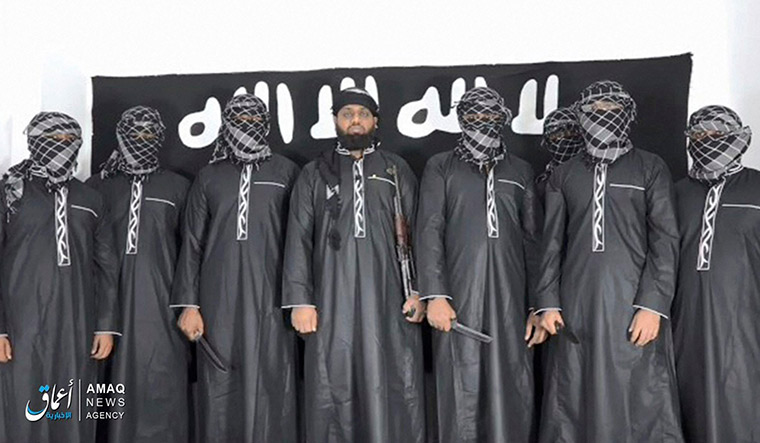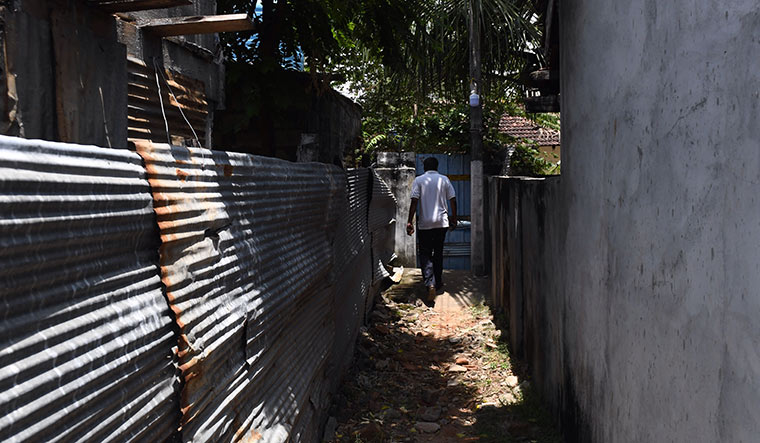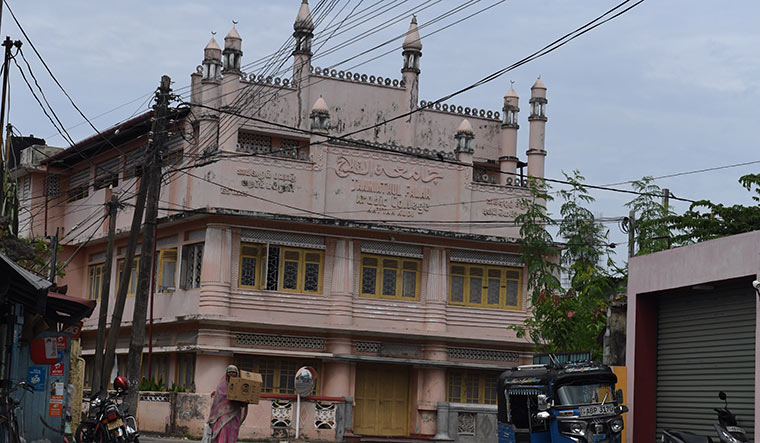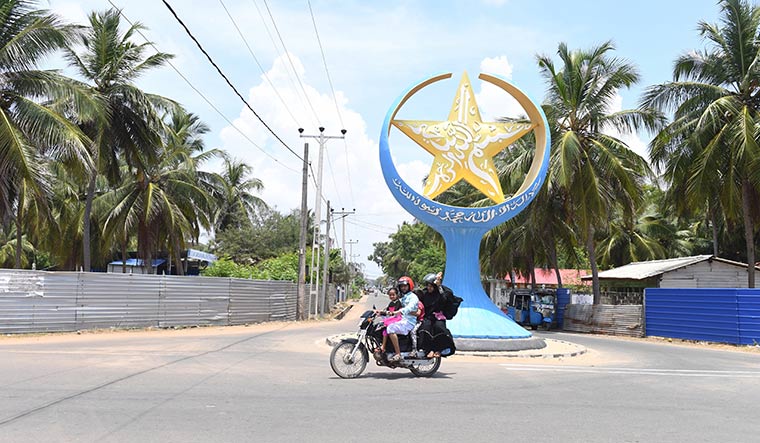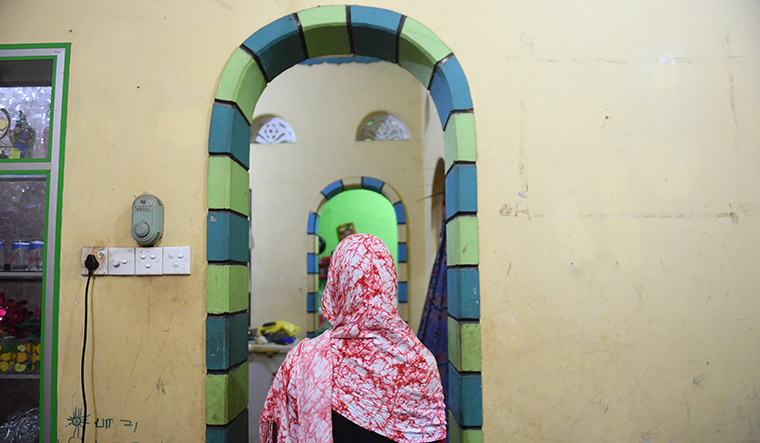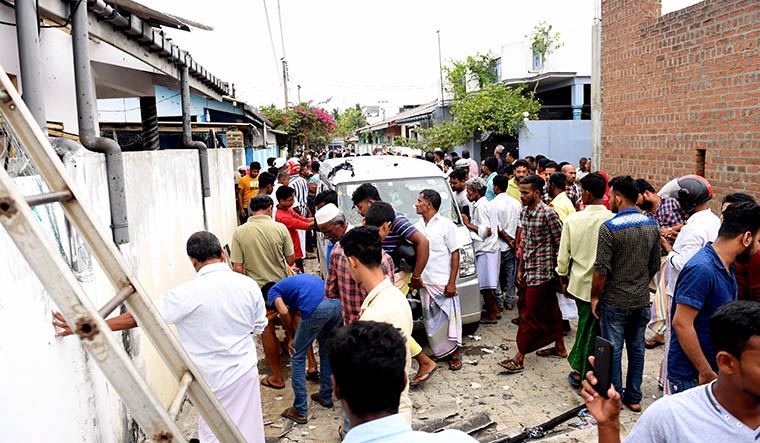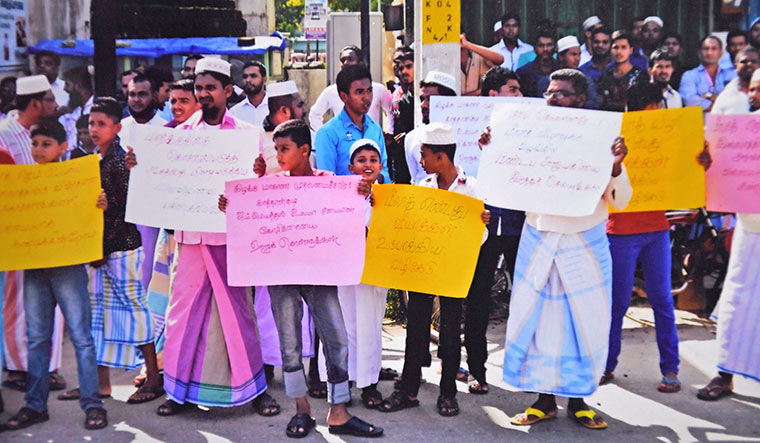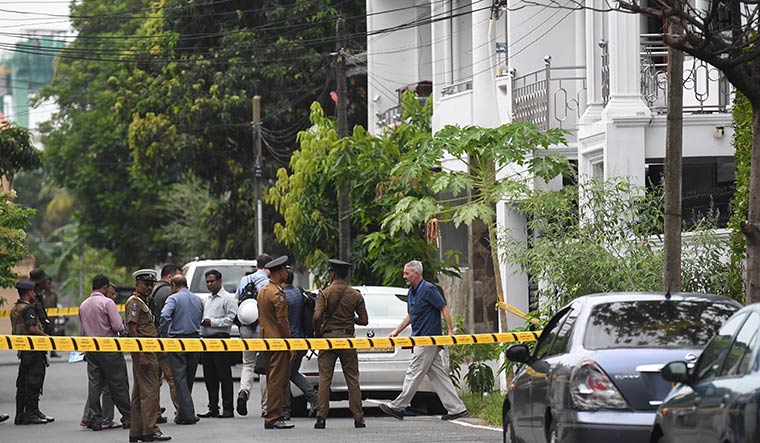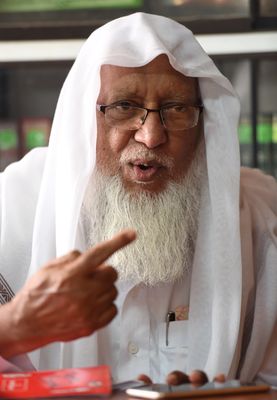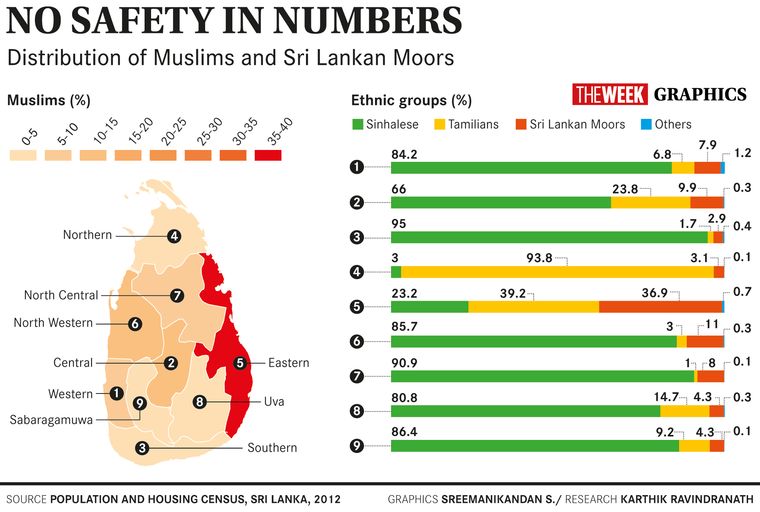An arched gateway featuring verses from the Quran welcomes you to Kattankudy, a coastal town in the eastern Batticaloa district of Sri Lanka. Date palms line the road beyond the arch. Cafes sit cheek by jowl on either side of the road and offer tiny cups of Middle Eastern coffee; a rarity in the land of Ceylon tea. A monument in the shape of a rehal (book rest) adds to the Arabic ambience of the town.
Like the rest of Sri Lanka, Kattankudy, too, is in grief after the April 21 blasts that killed more than 250 people in multiple cities across the country. But there is fear, too. For the mastermind of the attacks—Zahran Hashim—was a native of Kattankudy. It is here that he established the National Thowheed Jamaath, the radical group that bombed Sri Lanka on Easter Sunday. Zahran reportedly blew himself up for the attack.
“He learned Islam the wrong way,” Mohammed Aliyar Falahi, who once taught Zahran, told THE WEEK. Falahi is vice principal at the Jamiathul Falah Arabic College, which had kicked out Zahran because of his radical views. “He was a half-baked person and did not even complete the course to become a maulvi. He was always ambitious, radical and violent in his thoughts.”
But he was not alone. Most of the Muslim youth in Kattankudy have turned to monotheism and radical preaching, which came from the Middle East. Kattankudy, which borders the Tamil towns of Manjanthoduvai and Arayampathy, has 66,000 Muslims. Overall, Muslims make up 9.7 per cent of 21 million people in Sri Lanka. But unlike the Tamil minority, Muslims have largely kept away from violence and have kept to themselves.
In its early days, Kattankudy had been a Sufi town. But, in the late 1970s, things began to change. The youth who went to work in the Middle East brought back more than just dates and perfumes. Saudi money started pouring in, and mosques and madrassas were built. “This is when Wahhabism began coming into our country,” said M.I. Mohammed Jaseem, vice chairman of the Kattankudy Urban Council. The youth began questioning the Sufi way and turned to early Islam.
“We were basically practising traditional Sufism and believed in idol worship,” said Falahi. “It is believed that our ancestors came from Yemen and married the Tamil women here. This is why we speak Tamil. Our women never covered their faces with a hijab. They used to veil their head with the sari.”
Though Kattankudy spans just 3.9 square kilometres, it has more than 45 mosques. The new Kattankudy Grand Jumma Mosque, with its blue mosaics and Arabic letters on the dome, looks exactly like the Al-Aqsa Mosque in Jerusalem, the third holiest site in Islam.
By the late 1980s and early 1990s, Wahhabism, born in Saudi Arabia, began taking hold on the Sufi Muslims of Sri Lanka. “Their first campaign was against the Sufi Muslims,” said a senior member of the Alhaj Abdul Jawadh Ali Walaiyyullah trust. “The youth who came back from Saudi Arabia, even before people like Zahran [came up], began criticising our worship practices. They wanted us to practise monotheism.”
The trust runs the Badriya Jumma mosque, which was one of the Wahhabis’ early targets. The first terror attack was on May 29, 1998, when Farooq Maulvi, who fought the Wahhabi ideology, was killed. The seeds of distrust were sown in Kattankudy.
Then, on October 31, 2004, a mosque at Irumbuthaikkan in Batticaloa was attacked. Though no one was hurt and the mosque was undamaged, it led to a weeklong episode of violence in the area. Reportedly, even the Sufis got rough. Though the dust settled and people went on with their lives, their minds had been partitioned. Many of the women who had returned from the Middle East began wearing hijabs. “In our society, the women could decide whether to cover their faces or not,” said Mohammed Jaseem. “It was only during the early 2000s that the youth began talking about the hijab being compulsory.” The Wahhabis also told their women not to wear jewellery. “We were always for jewellery,” Jaseem said. “The women were like their Muslim sisters in regions like Ramanathapuram and Nagoor in Tamil Nadu.”
The fear had set in. The liberal women of Kattankudy started staying indoors and covered their faces while outside. The town also saw the advent of radical preaching on the “morality of the right things”, and emotional sermons on the Quran and Hadith. By mid-2006, the region was a tinderbox.
And then a match was lit. According to the Sufis, various small outfits, including the Kattankudy mosque federation and Jamiatul Ulama, came together under the name Eemaniya Nenjangal. The members of this group began telling the Sufis to convert to Wahhabism.
On July 31 the same year, one of the radical groups reportedly abducted Maulvi Mohamed Rizvi while he was going to the Oddamavadi Grand Mosque. He was blindfolded and taken to an unknown location, where he was beaten up and his beard was shaved. He was freed two days later. The maulvi had been punished for his remarks against one of the Wahhabi groups.
Around the same time, a man called Abdul Samad, alias Kaju Samad, known to be a weapons procurer for a local radical group, was found dead in Eravur. The police closed the case, saying that he was “abducted and killed” by an “unidentified group” because of “rivalry between two local groups”.
Later that year, about 50 Sufi houses and madrassas were gutted. “Our people became refugees in our own land,” says Zareen Mohammed, a practising Sufi. A week later, on November 7, Abdur Rauff Maulvi of the Alhaj Abdul Jawadh Ali Walaiyyullah trust was shot at. He escaped unhurt.
This was when jihadi training began in Sri Lanka. The monotheists started getting weapons into the country. They said it was their “duty to correct the Muslims who are going on the wrong path,” said Sahani, a resident of Kattankudy, recalling their speeches. The ground situation remained tense for the next few years.
Then, in 2014, Zahran Mohammed Hashim founded the National Thowheed Jamaath with just 40 members. His speeches lured hundreds more. Within a year, there were 400 members. A section of Muslims began looking at him as a promising leader. The NTJ’s monthly magazine regularly wrote against Buddhists and Sufi Muslims. Zahran even said that Muslims did not come under the Sri Lankan constitution and they need not follow any government rules.
Born in 1986 in Kattankudy, Zahran had had a difficult childhood. His father, Mohammed Hashim, sold small packets of food on the streets to make ends meet. But the money was not enough to sustain his family—him, his wife and five children (three boys and two girls). Perhaps that is why he turned to petty thievery; he was called ‘Kallan Hashim’ those days.
The family placed its hopes on Zahran, who joined the Jamiathul Falah Arabic College when he was 12. For three years, Zahran memorised the Quran, but at 15, he argued that his teachers were too liberal in their reading of the holy book. “He wanted radical Islam, so we threw him out,” said Falahi. The white-bearded man last heard of Zahran years ago. “I remember the day in 2005 when we kicked him out,” he said. “His father came to ask me where his son would go.”
Zahran left Kattankudy, learned Arabic, and returned to join the Dharul Athar mosque in 2006. Slowly, thanks to his oratory, he became a member of its management committee. But he fell out with the mosque after three years. Apparently, he never listened to the elders. He was conservative and advocated stoning people who spoke against Islam. “He had the habit of misquoting Islamic scriptures,” said Mohammed Yusuf Thowfeeq, a friend and now the in-charge of the NTJ. Because of heated arguments with members of the community, he left for Kurunegala, in northwest Sri Lanka, and married Fathima Cader Sadiya. It was here that he studied Islamic law and got the honorific mashoodi. “He was not a maulvi. He was only a mashoodi,” said Mohammed Jaseem. But Zahran was popularly known as Zahran Maulvi.
He came back to Kattankudy and formed the NTJ. “He was always emotional,” said Thowfeeq. “An able spiritual leader who could deliver lectures on the Quran and Islam nonstop.”
Zahran used to make his speeches at the Thowheed Jamaath mosque, which he started, and takers for his ideology grew. But things came to a head in 2017, when the NTJ held a special conference. Though Zahran claimed it was an anti-drugs event, one of the pamphlets, accessed by THE WEEK, said it was a talk on monotheistic ideology. The topic was—“Why not call pantheists the people who converted from Islam?”
The conference turned violent, following which eight people were arrested and four others—Zahran, his brother Rilwan, Anwar Asthaq and Bathrudeen Mohideen—went missing. While Rilwan returned to lead the NTJ, Zahran went into hiding. The NTJ decided to dismiss Zahran, as he had turned radical, and Rilwan signed the letter himself.
Soon after the violent conference, Sufi Muslims, placards in hands, demanded Zahran’s arrest. “We prepared a long list of these people, with their names, addresses, their fundamentalist ideologies and IS (Islamic State) inclinations and sent it as a complaint to every top authority in the country,” said Sahani, who did not want to disclose his second name. “We sent it to the attorney general and also to the IGP (inspector general of police) office in Colombo. But no one took it into consideration.”
But then, even the people of Kattankudy did not think Zahran would go to such extremes. “We thought people like Zahran were just loudmouths. We never expected that he would harm the country with such terror,” said Abdul Latheef Mohammed Sabeel, a local urban council member.
The numbers, however, show his impact. Apparently, 80 per cent of the Muslims in Kattankudy now follow Wahhabism. “The Muslims who follow Sufism are around just 20 per cent,” said a member of the Badriya Jumma Mosque.
THE ONE WHO LIVES
“Zahran was always very kind and helpful,” his sister, Madhaniya Niyas, told THE WEEK. “But, in 2017, I stopped meeting him as he began talking about hardline religion. My husband didn’t like Zahran. So I stayed away.”
A frail 26-year-old mother of three, Madhaniya was in a bad state. She and her husband had not eaten properly after learning of the Easter blasts. “We were shocked,” said Niyas. Their nine-month-old son was crying, presumably from hunger. “Now no one from my family is alive,” said Madhaniya. She had just returned from the Ampara government hospital, where she was made to identify the bodies of her two brothers, their wives, their children, her younger sister and her husband, and the daughter of Zahran’s friend Niyas. They had died in a gun battle with security forces in Sainthamaruthu, near Kattankudy. Apparently, the men in the safe house had detonated explosives, blowing up themselves and the others. “My sister was pregnant,” Madhaniya said in a low voice.
Madhaniya and Niyas live on rent in a small, two-bedroom house. Niyas, who buys and sells autos, has had a horrid time in the past few days. Investigative agencies have mistaken him for Zahran’s friend with the same name, who died at the safe house. “The special task force came looking for Niyas and took me into custody,” said Madhaniya. “I had a tough time making them understand that my husband is alive.”
After Zahran went missing in 2017, Madhaniya was not in touch with him. In fact, she was only in contact with one of her brothers, Zaini. And her parents. They lived three blocks away from her, and she sent them food the Thursday before the April 21 attacks. But, on Saturday, when she went looking for her parents, their house was locked. “I didn’t know where they went. The neighbour said they had gone out on Friday,” she said.
So, on Sunday, when the blasts happened and the news of Zahran’s involvement came out, she thought that the family had gone to a safe hiding place. A week later, she found out that the whole family had died. “It was a horrible scene at the hospital,” she said. “The bodies had been blown to pieces and were kept in plastic bags. I could not identify anyone except Niyas. I identified them only in the video and in the photos shown to me.” As she spoke, her four-year-old daughter played with a soft toy with broad eyes and white hair. THE WEEK had seen a similar toy at the blast site in Sainthamaruthu. “My sister’s daughter had a similar toy,” she said. “My daughter cried when she saw it and I bought it for her.”
Back at the Ampara hospital, near the mortuary, Zahran’s wife and four-year-old daughter sat in silence. “She is in terrible shock, but is not injured,” said Madhaniya, before calling out to her. She did not respond. Fathima and her daughter were inside a room at the Sainthamaruthu safe house when it was raided. “She is innocent, as far as I know,” said Madhaniya. “She is sitting like a stone in the hospital.”
THE WEEK then saw Niyas’s wife, Syed Ahmed Asmia, at the Kattankudy police station. Niyas had left home a few weeks before the Easter attacks, saying he was going to Saudi Arabia for a job. The police were interrogating Asmia, who was seven months pregnant, to find out more about him. “Did he talk about IS at home?” asked the officer. “He talked about Zahran and his talks on Islam,” Asmia replied. “He would say non-Muslims have to be killed. But he would never wait for my reply.”
GROWING PAINS, INTELLIGENCE ERRORS
Though Zahran started the NTJ in Kattankudy, his connections are said to have grown steadily, especially through organisations in Colombo.
“There are many organisations in Colombo that bring people from other countries to preach Islam,” said a civil society leader in Batticaloa. “Organisations like Sri Lanka Thawheed Jamath and Ceylon Thowheed Jamath.”
And with the focus of the security agencies elsewhere, Zahran decided to take a chance. Last year, two policemen were stabbed to death near the Kallady bridge in Batticaloa. The police got suspicious of some former LTTE cadres and arrested them. However, Zahran’s driver Gaffur has now confessed to the police that he killed the policemen, and it was a test to know if the police would suspect them for any attacks. “He has confessed,” Kasthuri Araichchi, the officer in charge at the Kattankudy police station, told THE WEEK.
After Zahran married Fathima, he starting spreading his ideology in Kurunegala, too. And his connections grew. It was after 2017, when Zahran went missing, that his Facebook postings became aggressive. “The National Thowheed Jamath, though founded by him, always supported peace,” Yusuf Mohammed Thowfeeq told THE WEEK. It was in the later years that Zahran began talking about the shariah law. “We are for the shariah law,” said Yusuf. “But we don’t agree with the crude parts like stoning or cutting off hands for stealing. We said women should wear a hijab, cover their faces and not wear jewellery. This is because piercing the ears could harm them.”
The police were investigating how Zahran got in touch with the sons of spice trader M.Y. Ibrahim in Dematagoda, Colombo. Inshaf and Illham were involved in the Easter attacks in Negombo. Ibrahim has been arrested. “Islamic fundamentalism in Sri Lanka began in 2007 itself,” said a former intelligence officer who worked in the Mahinda Rajapaksa government. “There were at least 25 homegrown groups that were talking Islamic fundamentalism.” But the Rajapaksa government apparently had a tight grip on the Muslim community and some of them even helped the government fight the LTTE.
However, towards the end of the civil war, said the officer, the government became suspicious of a senior Muslim politician providing weapons and training to some radical groups. It was in 2010, a year after the war, that the radical groups became prominent in Sri Lanka. “They became more powerful than their own brethren in the community because of their connections with politicians,” said the officer.
This is when preachers from countries like Saudi Arabia, Iraq and Pakistan began coming to Sri Lanka. Apparently, three days after the Easter attacks, security agencies detained a preacher from Egypt, who did not have a valid visa or passport, and was preaching in schools on the outskirts of Colombo. “This is how it was working,” said the officer. “The government failed to keep tabs on the fundamentalist preaching happening in the capital.”
Apparently, after the war, Sri Lanka had a military intelligence unit that exclusively monitored Islamic radicalisation. However, according to officers who were part of the unit, the Maithripala Sirisena government did away with it.
A few days after the Easter attacks, the police detained one of the brothers of Industries Minister Rishad Bathiudeen; he was later let off. Also, people have alleged that the governor of the Eastern Province, M.L.A.M. Hizbullah, was promoting fundamentalism. Apparently, he was involved in the setting up of a Sharia law university near Batticaloa. Being built at a cost of 1500 million Sri Lankan rupees, the university is said to be partly funded by Saudi Arabia. THE WEEK could not reach Hizbullah; sources said he wanted to stay away from any controversy. The construction has been halted after the recent attacks.
Earlier, in January, security agencies had arrested four men after a huge cache of explosives was found on an 80-acre coconut farm in Puttalam district in northwestern Sri Lanka. They were released later. The police are now investigating whether the case is connected to the blasts.
The police have also found another safe house of Zahran, from information given by his driver Gaffur, at Hambantota. They had earlier seized a huge haul of detonators and weapons, and an IS flag, from another safe house in Sammanthurai. According to intelligence sources, the NTJ’s route to Syria was through Afghanistan. The Kattankudy police are now on the lookout for at least 56 people who they think have IS links.
Though it has been more than a week since the Easter attacks, and curfew has been lifted in Colombo and Batticaloa, people are still wary. “On Sunday, we organised a mass, eight days after the attacks,” said Rajan Roshan, the priest at a Batticaloa church. “But people did not turn up.”
Few would blame them.



